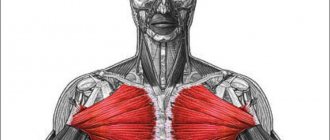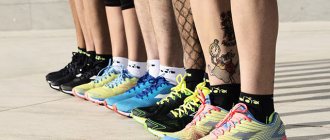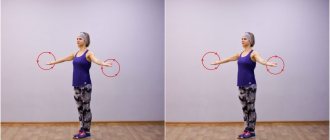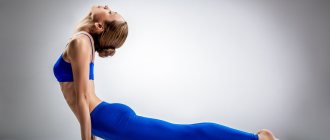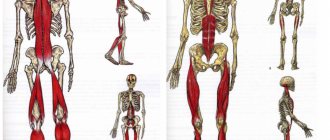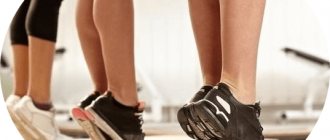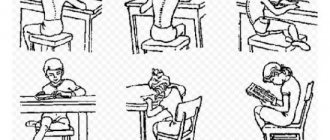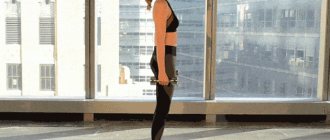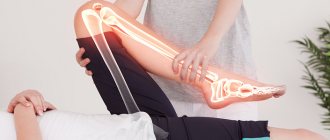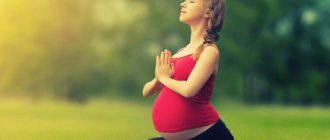Scoliosis is a postural disorder in which a lateral curvature of the spine occurs in the shape of the letter C or S. This disease of the musculoskeletal system introduces significant disharmony into a person’s appearance, and over time can have a negative effect on internal organs (heart, lungs, stomach). The use of exercise therapy as part of the treatment of scoliosis allows you to completely eliminate the problem in the early stages, and in advanced stages 3 and 4, exercises become an integral part of the treatment complex.
From this article you will learn what the rules are for performing exercise therapy for scoliosis and what exercises it includes. Following the recommendations listed above will help eliminate the problem with the spine or obtain reliable prevention.
Exercises for scoliosis of the spine: features
It is unlikely that any modern medicine can replace physical therapy. A regularly performed set of exercises for scoliosis helps to cope with the following tasks:
- restore strength and elasticity to mice, form a strong muscular frame of the spine;
- eliminate pathological tension from muscles;
- prevent the progression of the disease by stopping the increase in the angle of curvature of the spine;
- improve the functioning of the heart and blood vessels, normalize breathing;
- reduce or completely eliminate lateral curvature of the spine.
In view of this, therapeutic exercises for scoliosis are a key method of conservative treatment, and this is recognized by orthopedists and speech therapists around the world. Sets of exercises can be used as the only method of therapy in the initial stages of pathological curvature of the spine. They are also necessarily used in the treatment of stages 3 and 4 of scoliosis.
Scoliosis very often develops during the intensive growth of a child. During this period, the segments of the spine are still very unstable, and physical impact on them should be very careful and as professional as possible. Otherwise, serious harm is possible, namely aggravation of the angle of curvature, pinching of internal organs, disruption of the heart and respiratory system.
In order for the exercises to be effective, you need to select them taking into account which part of the spine the disorders develop in. They need to be done regularly, and an instructor must first teach the technique.
Indications for the use of therapeutic exercises
Therapeutic exercise is recommended at any age and is prescribed for a wide variety of diseases.
Indications for exercise therapy:
- Clinic of Internal Medicine;
- neurosurgery, neurology;
- obstetrics and gynecology;
- orthopedics, traumatology;
- after surgical operations of internal organs;
- psychiatry;
- pediatrics;
- phthisiology;
- ophthalmology (for simple myopia);
- oncology.
Contraindications
The list of contraindications is small and includes the initial period of the acute form of the disease or exacerbations of chronic forms.
Absolute contraindications:
- serious condition of the patient;
- acute forms of chronic diseases;
- heat;
- severe pain of any origin (except for phantom pain);
- bleeding or the risk of its development due to increased physical activity;
- signs of intoxication (leukocytosis, increased erythrocyte sedimentation rate, malaise);
- conservative therapy of malignant neoplasms.
In addition to absolute contraindications, there are diseases that require restrictions on exercise therapy.
Restrictions:
- diseases of the cardiovascular system (absence of arrhythmia, cardiosclerosis, myocardial dystrophy, chronic myocarditis);
- pathologies of the respiratory system (bronchial asthma, pneumosclerosis, chronic bronchitis, emphysema);
- gastrointestinal diseases (stomach and duodenal ulcers, gastritis);
- metabolic diseases (obesity, diabetes requires monitoring by an endocrinologist);
- pathologies of the nervous system (organic and functional lesions of the central nervous system);
- diseases of the visual organs (previous scleroplasty surgery, moderate and high degrees of myopia, threat of retinal detachment) - jumping and jumping rope are prohibited;
- diseases of the spine - twisting and jumping are prohibited.
Gymnastics for scoliosis at home: basic rules
Exercises for the back for scoliosis must comply with several basic rules, which must be taken into account when compiling a complex.
1. It is important to exclude all types of exercises that can aggravate the condition of the spine. These include the following:
- pull-ups and hanging on bars and wall bars;
- elements from acrobatics, such as somersaults, jumps, “swallow”;
- strength exercises using dumbbells and weights;
- fast run;
- any jumps;
- rotation of the torso in a vertical position.
2. The first classes should be carried out at a slow pace. It is necessary to control and monitor the body's reaction to any of the exercises.
3. Loads with the number of repetitions are set gradually so that the muscles and spine are not overstrained
4. The exercises are designed exclusively for passive traction of the spine.
5. You need to regularly alternate exercises for the muscles of the shoulder girdle and exercises for the legs and lumbar region.
Exercises for spinal scoliosis at home, which were prescribed by a doctor, must be repeated every day, without breaks. After finishing the session, take a rest, lying on your side for 30 minutes during treatment.
Stages of training for scoliosis
Each session should be carried out clearly in accordance with the training plan - this will help to get the maximum effect from each exercise.
Classes are divided into the following stages:
- Warm up . It involves preparing the ligamentous apparatus to perform basic loads, stimulating blood circulation in muscle tissue, and establishing the correct breathing rhythm.
- Basic loads . They include correction of pathological curvature, stimulation of muscle motor activity, as well as restoration of the correct functions of internal systems in the body.
- Conclusion . At this stage, we gradually reduce the load and restore the usual breathing rhythm.
At each stage, it is important to pay enough attention to proper breathing. This will help stimulate the functioning of the lungs and provide additional oxygen to the muscles.
Exercises for scoliosis at home: an approximate set
Remember that each element of physical therapy for scoliosis must be selected individually. Let us give an example of a standard lesson used for this problem.
Warm-up
A set of physical therapy exercises for scoliosis should begin with straightening the back. First, press your back against any flat, vertical surface, making sure that your calves, shoulder blades and buttocks are touching it. Try to remember this position and not change it. Now you need to take two steps back.
Now the actual exercises:
- Stand straight with your feet shoulder-width apart. At the same time, raise both arms up, spread them to the sides and slightly back. You need to repeat the exercise four times.
- Stand up straight, put your feet together, place your hands on your waist. Alternately bend your knees, lifting them up a little, and squat shallowly. Repeat 3-5 times.
- The starting position is similar to the previous exercise. Walk in place. When walking, do not raise your knees high. Inhale for a count of one or two, and exhale for a count of three or four. As you inhale, raise your arms up to the sides, and as you exhale, lower them smoothly.
Basic exercises
These exercises to correct scoliosis will be as follows:
- Lie on your back, place your hands behind your head. While inhaling, spread your elbows to the sides, exhaling, take the starting position. These measures must be repeated five times.
- The starting position is similar. Bend one leg, pull your knee towards your stomach, repeat the same with the other leg, then both together. You need to repeat the exercise 3-4 times.
- You need to lie on your stomach, stretch your arms at your sides, and place your palms on the floor. As you inhale, leaning on your hands, lift one leg up as far as you can. Then, as you exhale, return to the starting position. Repeat the same for the other leg. It is recommended to repeat each exercise at least three times.
- Now lie on your back, stretch your arms along your head. You need to do passive traction. As you inhale, try to pull your head and shoulders up and your legs down at the same time.
- Lie on your stomach. Simultaneously imitate movements with your arms and legs, as when swimming.
Final exercises
They will be as follows:
- You need to stand up straight and place your hands on your belt. You need to walk in place. When walking while inhaling, raise your arms up and at the same time switch to walking on your toes. Exhaling, lower your arms and now walk on your heels.
- The starting position is similar. Walk with your knees high.
In the photo you will see an approximate set of exercises for scoliosis.
Folk remedies
It is worth noting that you can also use various traditional methods to get rid of the problem. These can be infusions for oral administration, ointments and mash for external use. However, before using them, you should definitely consult with your doctor and make sure that this will not cause any harm to the body.
Spinal scoliosis is a disease that often affects children and adolescents. In the absence of timely treatment, this pathology remains with the person for life. Sometimes scoliosis can occur in adulthood, under the influence of certain factors. Scoliosis significantly complicates a person’s life – both physically and psychologically. It is much more difficult to cure spinal scoliosis in adults than in children, since the bone tissue is already fully formed.
Scoliosis in adults most often occurs as a result of incomplete or incorrect treatment of this pathology at a young age, or lack of treatment as such. But other factors that provoke degenerative phenomena in the spine can lead to the development of this disease:
- injuries resulting in spinal column defects;
- diseases of the spine - osteochondrosis, protrusions, hernias, lordosis, disc displacement and others;
- previous spinal surgeries;
- osteomalacia is a pathology in which the bone tissue of the spinal column softens;
- osteoporosis – decreased strength, thinning of bone tissue;
- malignant neoplasms localized in the spine or giving metastases to the vertebrae;
- infectious diseases - for example, ostiomyelitis or tuberculosis can affect the condition of bone tissue;
- idiopathic causes, i.e. the factors responsible for the formation of the disease cannot be precisely determined.
Obesity, poor posture, and lack of physical activity can also affect the development of spinal scoliosis in adults. Taking any measures to self-heal is strictly contraindicated. The spine is no joke and, with an illiterate approach to treatment, it can significantly worsen your health.
Scoliosis is characterized by pronounced symptoms, the main of which is pain in the back. In addition, the following symptoms are observed:
- rachiocampsis;
- the formation of a rib hump, which becomes more noticeable in an inclined position of the body;
- visually there is a difference in the length of the upper limbs;
- difficulties, discomfort when moving;
- asymmetrical arrangement of shoulders, back, shoulder blades;
- nagging pain in the arms;
- malfunctions of internal organs, as a result of which the patient is susceptible to frequent colds;
- lameness, increased fatigue when standing for a long time;
- numbness of the limbs associated with compression of the nerve endings by the damaged spinal column;
- indigestion;
- in women - hormonal disorders, inflammation of the uterus and ovaries, cholecystitis; in men – sexual dysfunction.
In severe cases, scoliosis can manifest itself as heart failure, disruptions in the functioning of the nervous system, diseases of the kidneys and gastrointestinal tract. In the absence of medical assistance, the disease can cause a number of dangerous complications, so treatment should not be delayed.
The best exercises for scoliosis
Swiss orthopedists and vertebrologists, together with exercise therapy specialists, have developed a set of exercises to correct scoliosis, which helps to effectively use the main muscle groups, increasing their firmness and elasticity. It includes the following exercises:
Exercises for back muscles:
- Lie on your stomach with your arms at your sides. Raise your head up and try to raise your shoulders, while at the same time squeezing your hands into a fist and unclenching them. Start with five times, gradually increase this number to 15.
- Lie on your stomach and place your arms along your torso. Raise your legs one at a time without lifting your pelvis from the floor. The exercise must be repeated five times.
Exercises for the lateral back muscles:
- Lie on your right side, now lift your right leg up along the side of your body, and place your left leg flat on top. Smoothly raise your left leg and lower it just as smoothly. Repeat for each side five times.
- Lie on your side. Stretch your lower arm up and rest your other hand on the floor at chest level. Raise both legs as far as you can. Repeat the same for the other side. For each side you need to do 3 times.
For the abdominal muscles, do the following exercise:
- You need to lie on your back, place your hands at your sides. Raise one leg without bending your knee and hold for a few seconds. Repeat the same for the other leg. Then lift your two legs together. Start with three repetitions, then increase the load to 7 times.
Exercise to correct posture:
- Lie on your back. Keep your legs together, place your arms along your body. You need to raise your head and shoulders for a second, then smoothly lower them, without jerking.
Exercise to straighten the spine:
- For this exercise, you will need to prepare a bag of sand weighing no more than 1 kg in advance. Sit on a chair, place the bag on your head so that it does not fall. Then get up smoothly and walk around a little so that the bag does not fall off your head.
Types of exercise therapy loads for scoliosis
Lateral curvature of the spine leads to heavy loads on the ligamentous apparatus. Paired muscles receive significant differences in tension. The muscles on the convex side are constantly toned, which over time leads to deterioration and loss of their contractility. Their paired “opponents” on the opposite side are always contracted and relaxed. Due to the lack of movement, they are weakened, which can further provoke atrophy.
Therefore, it is important that exercises for the treatment of scoliosis at home include four types of loads:
- Asymmetrical . They allow you to train muscles on only one side of the body, while the opposite muscle group is relaxed.
- Symmetrical . They help keep the spine in a natural position from an anatomical point of view. The load is equally distributed on the muscles on both sides, as a result their tone is equalized, and this has a beneficial effect on the dynamics of spinal alignment.
- Detorsion . They help relieve strain from tense muscles, while simultaneously stimulating the work of relaxed ones.
- General strengthening . They help stimulate the immune system, help increase endurance and improve the overall physical development of the whole body.
Please note that the effectiveness of physical therapy for scoliosis will be determined by how responsibly you take the exercises and whether you follow all the instructions. It is also important to constantly monitor your posture.
Preventive measures
A significant addition to exercise therapy will be preventive measures to help stop further progression of the disease. First of all, you should try to lead an active lifestyle and engage in non-traumatic sports. The ideal choice would be swimming, which is used for the prevention and treatment of many spinal diseases. Swimming allows you to relax, strengthen your back muscles and improve coordination of movements. Cycling and skiing will also be beneficial, but only with moderate activity. In prevention, there are a number of recommendations to avoid asymmetrical load on the back muscles, which will help maintain the spine in an anatomically correct position. Let's highlight the most important of them:
- Always sit up straight, do not bend your torso excessively and tilt your head forward as little as possible.
- The height of chairs and armchairs should be selected according to the length of the lower leg, so when sitting, your leg should not hang, but rest on the floor.
- If you spend a lot of time sitting, it is recommended to get up every 20 minutes and, if possible, stretch a little.
- Periodically do slow backbends throughout the day to relieve tension in your back muscles.
- When you need to stand for a long time, try alternately leaning on one leg and then on the other. Change position every 10 minutes, this will reduce the load on the spine.
- Do not carry heavy weights in one hand, always distribute the load evenly on both hands.
- To relax, use a bed with a medium-hard mattress; choose a small pillow so that your neck is in line with the rest of the spine.
Finally, I would like to note that you should not independently develop a complex of exercise therapy for yourself, as well as use complex asymmetrical exercises without the consent of a qualified doctor. Remember that such actions can only aggravate the situation, lead to complications and accelerate the development of the disease.
Video on the topic:
